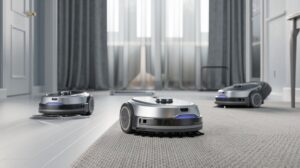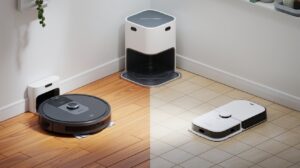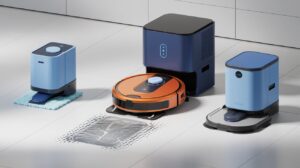Robots That Mop and Vacuum: Are They Worth It?
In today’s fast-paced world, time-saving solutions are a necessity, and smart home devices are at the forefront of this revolution. Among the most popular innovations are robots that mop and vacuum, offering dual-functionality to keep your floors spotless with minimal effort. These automated cleaning devices are equipped with advanced features such as app controls, room mapping, and obstacle detection, making them an appealing choice for busy households.
But are these smart cleaning devices truly worth the investment? In this article, we’ll dive into the world of robot vacuum and mop combos, exploring their benefits, limitations, and whether they’re a practical addition to your home. By the end, you’ll have all the insights needed to determine if these automated floor cleaners are the right fit for your lifestyle. Let’s get started!

What Are Robot Vacuum-Mops?
Robot vacuum-mops are cutting-edge cleaning devices designed to combine vacuuming and mopping functions into a single automated tool. Unlike traditional cleaning methods, these dual-function cleaning robots offer a hands-free approach to maintaining clean floors. Equipped with advanced technologies such as smart navigation, scheduling, and multi-surface adaptability, they have become indispensable for many homeowners seeking convenience and efficiency.
The concept of robotic cleaners originated with simple vacuum models like the Roomba, which revolutionized home cleaning in the early 2000s. Over the years, technology has evolved, leading to the integration of mopping capabilities. Today’s robot vacuum-mops are capable of handling everything from loose dirt on carpets to sticky spills on hardwood and tile floors.
How They Work
A robot vacuum-mop typically uses a combination of sensors, brushes, suction, and a water tank to perform its tasks. When vacuuming, the device collects dirt, debris, and pet hair using rotating brushes and powerful suction. For mopping, it dispenses water or cleaning solution onto the floor while a microfiber pad wipes the surface clean. Some advanced models even allow you to control the water flow based on the type of flooring.
Many models are equipped with smart mapping technology, enabling them to navigate your home efficiently. Using laser sensors or cameras, they create a map of your living space to avoid obstacles and cover every area without redundancy. This feature is particularly useful for large homes with complex layouts.
Key Features of Robot Vacuum-Mops
- Smart Navigation: Advanced mapping systems ensure efficient cleaning paths and minimal missed spots.
- Multi-Surface Compatibility: They can transition seamlessly between carpets, hardwood, and tiles.
- App Controls: Most models allow you to schedule cleanings, adjust settings, and monitor progress through a smartphone app.
- Obstacle Detection: Built-in sensors help them avoid furniture, stairs, and other obstacles.
- Customizable Cleaning Modes: From spot cleaning to edge cleaning, you can tailor their performance to specific needs.
Who Should Consider a Robot Vacuum-Mop?
- Busy Professionals: For those with little time to clean, these devices provide a reliable, hands-free solution.
- Pet Owners: They are highly effective at picking up pet hair and dealing with minor accidents.
- Families: With kids running around, these tools help keep floors consistently clean without constant effort.
- Tech Enthusiasts: If you’re a fan of smart home gadgets, adding a robot vacuum-mop to your collection is a logical step.
The Growing Popularity of Cleaning Robots
In recent years, robot vacuum-mops have surged in popularity due to their convenience and efficiency. As technology improves and prices become more accessible, these devices are no longer a luxury but a practical investment for many households.
Their ability to combine vacuuming and mopping into one streamlined process makes them stand out among other smart cleaning devices. Whether you’re tackling everyday messes or maintaining a pristine home, robot vacuum-mops are a testament to how technology can simplify modern living.
Benefits of Robot Vacuum-Mops
1. Convenience
One of the primary benefits of robot vacuum-mops is their convenience. Unlike traditional cleaning tools, these devices operate autonomously, giving homeowners a hands-free solution to daily cleaning tasks. Most models are equipped with mobile apps that allow you to schedule cleanings remotely, ensuring your floors stay spotless even when you’re not at home. For busy professionals and parents, this feature is invaluable.
2. Efficiency
Thanks to advanced navigation and mapping technologies, robot vacuum-mops are highly efficient at covering large areas without missing spots. Features like room mapping and multi-floor compatibility ensure they clean systematically and avoid redundancies. Their ability to detect high-traffic areas and adjust cleaning intensity further enhances their efficiency.
3. Versatility
Modern robot vacuum-mops are designed to handle multiple floor types, from hardwood to tiles and low-pile carpets. Some models even feature specialized settings for pet hair or stubborn stains. With dual cleaning capabilities, these devices can vacuum debris and mop spills in one go, making them a versatile tool for maintaining a clean home.
4. Smart Features
Many robot vacuum-mops come equipped with cutting-edge smart features, such as voice control, obstacle detection, and customizable cleaning modes. Voice assistant compatibility with platforms like Alexa or Google Assistant allows for effortless operation, while sensors prevent collisions with furniture and falls down stairs. These smart features make cleaning not only efficient but also highly user-friendly.
5. Time-Saving
Perhaps the most significant advantage is the time saved. Traditional cleaning methods can be time-consuming, especially for larger homes or households with pets and children. A robot vacuum-mop operates independently, allowing you to focus on other tasks or enjoy leisure time while your floors are cleaned.
6. Consistent Cleaning
For those who prioritize cleanliness, robot vacuum-mops offer consistent performance. Unlike manual cleaning, which can vary based on effort and time, these devices follow pre-programmed routines, ensuring your floors are cleaned regularly and thoroughly.
7. Ideal for Allergies
If you or your family members suffer from allergies, a robot vacuum-mop can help maintain better indoor air quality. Many models are equipped with HEPA filters that capture allergens, dust, and pet dander, reducing triggers and promoting a healthier living environment.
8. Cost-Efficient in the Long Run
While the upfront cost of a robot vacuum-mop may be higher than traditional cleaning tools, the time saved and the reduction in professional cleaning services can make them a cost-effective investment over time. Additionally, many models are energy-efficient, further reducing long-term expenses.
By integrating advanced technologies and offering unparalleled convenience, robot vacuum-mops are reshaping how we approach household cleaning. Their benefits make them an appealing option for anyone looking to simplify and modernize their cleaning routine.

Limitations of Robot Vacuum-Mops
1. Initial Cost
Robot vacuum-mops often come with a significant upfront cost compared to traditional cleaning tools. While they offer long-term value, the initial investment can be a barrier for some households. High-end models with advanced features like smart mapping and voice control tend to be the most expensive, often exceeding $1,000.
2. Maintenance Requirements
Although these devices are designed for convenience, they still require regular maintenance. Tasks such as emptying the dustbin, cleaning brushes, and refilling the water tank are necessary to keep the device functioning optimally. Additionally, replacement parts like filters and mop pads may need to be purchased periodically, adding to the overall cost.
3. Limited Deep Cleaning Capability
While robot vacuum-mops are excellent for everyday maintenance, they may not provide the same deep-cleaning power as traditional vacuums or manual mopping. For example, they can struggle with heavily soiled areas or thick carpets that require more intense suction or scrubbing.
4. Navigation Challenges
Despite advances in navigation technology, these devices are not foolproof. They can sometimes get stuck under furniture, tangled in cords, or fail to recognize certain obstacles. Homes with complex layouts or numerous items on the floor may pose challenges for even the most advanced models.
5. Water Management
The mopping function of robot vacuum-mops relies on a small water tank, which may not be sufficient for larger homes. Frequent refilling might be necessary, and some models lack precise control over water distribution, leading to uneven cleaning or potential damage to sensitive flooring like hardwood.
6. Noise Levels
Although quieter than traditional vacuums, robot vacuum-mops still produce noise during operation. The sound can be disruptive, especially if the device runs during work-from-home hours or at night.
7. Compatibility Issues
Robot vacuum-mops work best in homes with minimal clutter and low-profile furniture. Thick rugs, high thresholds, or uneven flooring can limit their performance. If your home has many such features, you may find these devices less effective.
8. Dependence on Technology
As with any smart device, robot vacuum-mops are reliant on technology, which can occasionally fail. Software glitches, connectivity issues, or battery degradation over time can impact performance. Regular software updates and proper care are essential to ensure longevity.
